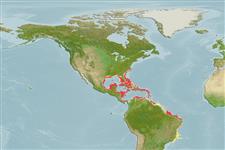Common names from other countries
Environment: milieu / climate zone / depth range / distribution range
Ökologie
seewasser riff-verbunden; tiefenbereich 6 - 73 m (Ref. 9710). Tropical
Western Atlantic: Bahamas, off Belize, Colombia, Bermuda, Puerto Rico, Antigua, Tortugas and off the Atlantic coast of Florida.
Size / Gewicht / Alter
Maturity: Lm ? range ? - ? cm
Max length : 6.3 cm TL Männchen/unbestimmt; (Ref. 7251)
Kurzbeschreibung
Bestimmungsschlüssel | Morphologie | Morphometrie
Pair of elongate fleshy tabs near tip of 2nd dorsal spine. Only one with the illicium shorter than 2nd dorsal spine.
Occurs mainly near patches of reef and rock. Relatively uncommon (Ref. 9710). Smallest frogfish in the western Atlantic (Ref. 26938).
Life cycle and mating behavior
Maturities | Fortpflanzung | Spawnings | Egg(s) | Fecundities | Larven
Oviparous.
Robins, C.R. and G.C. Ray, 1986. A field guide to Atlantic coast fishes of North America. Houghton Mifflin Company, Boston, U.S.A. 354 p. (Ref. 7251)
IUCN Rote Liste Status (Ref. 130435)
CITES (Ref. 128078)
Not Evaluated
Bedrohung für Menschen
Harmless
Nutzung durch Menschen
Fischereien: kleinfischerei
Tools
Zusatzinformationen
Download XML
Internet Quellen
Estimates based on models
Preferred temperature (Ref.
115969): 23.7 - 28, mean 26.6 (based on 288 cells).
Phylogenetic diversity index (Ref.
82804): PD
50 = 0.5005 [Uniqueness, from 0.5 = low to 2.0 = high].
Bayesian length-weight: a=0.01995 (0.00906 - 0.04395), b=3.01 (2.83 - 3.19), in cm Total Length, based on all LWR estimates for this body shape (Ref.
93245).
Trophic level (Ref.
69278): 3.6 ±0.6 se; based on size and trophs of closest relatives
Widerstandsfähigkeit (Ref.
120179): hoch, Verdopplung der Population dauert weniger als 15 Monate. (Fec assumed to be > 10,000).
Fishing Vulnerability (Ref.
59153): Low vulnerability (10 of 100).
